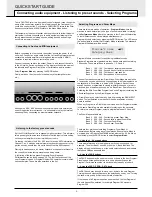
It is recommended that this chapter is read carefully if you are unfamiliar
with how MIDI works. Experienced users can skip this chapter and move
on to the next chapter
Main Features and Operation
on page 18.
About MIDI
MIDI is an acronym for Musical Instrument Digital Interface. The MIDI
standard was devised in the early 80’s as a means for allowing musical
instruments to communicate with each other as well as with other devices
such as sequencers and computers. Before the advent of MIDI, it was
often very difficult (if not impossible) for instruments to effectively commu-
nicate with each other, especially if they had been made by different man-
ufacturers. Nowadays, most types of electronic musical equipment are
equipped with a MIDI interface fitted as standard, including synthesizers,
drum machines, samplers, sequencers, computers and even some effects
units.
The MIDI standard allows many different instruments to be controlled at
once (say from a sequencer) using the same network of MIDI cables.
Each instrument in the MIDI chain is usually assigned its own unique MIDI
channel and will only respond to information that it may receive on that
particular channel. The MIDI standard allows for sixteen different channels
to be assigned to the various instruments in a MIDI network, which of
course means that it is possible to have up to sixteen instruments playing
simultaneously within a MIDI system.
Some people may feel that being restricted to just sixteen MIDI channels
might be a little limiting, especially if they are composing very complex
pieces of music. However, some sequencers and MIDI ports for comput-
ers offer a neat way around this problem. They can offer several different
MIDI outputs, each of which is treated as a separate MIDI system in its
own right with its own set of sixteen MIDI channels.
There are three MIDI sockets fitted at the rear, labeled ‘In’, ‘Out’ and
‘Thru’. Each one of these sockets has a specific purpose :
The MIDI IN Port
This is used to receive MIDI information to the KS 4 / KS 5, such as
telling it which notes to play from a sequencer for example.
The MIDI OUT Port
This transmits any MIDI information which might be generated by the KS
4 / KS 5. For example, if a note was played on the keyboard or one of the
knobs were moved on the front panel.
The MIDI THRU Port
This simply re-transmits any MIDI information that has been received at
the MIDI In socket. This socket is useful for connecting other instruments
into the same MIDI network. By connecting a cable from the MIDI Thru to
another instrument’s MIDI In socket, both the KS 4 / KS 5 and the second
instrument could be controlled simultaneously from a sequencer.
As seen in the diagram, if desired, the process can be repeated; a third
instrument could be added to the same MIDI network, simply by connect-
ing a cable from the second instrument’s MIDI Thru to the third instru-
ment’s MIDI In, and so on.
Some non-Novation instruments may not have a MIDI Thru socket fitted.
In these cases, the instrument should be placed at the end of the MIDI
chain or a Thru box should be incorporated into the MIDI system.
A Thru Box simply provides a number of identical MIDI Thru sockets from
a single MIDI In.
It is important to realise that MIDI information
flows in one direction only
along the cable.
It is not possible to have a MIDI In socket connected to
another MIDI In socket for example. If this were done, the MIDI network
would simply not work ! In fact, the only routings allowed are MIDI Out to
MIDI In or MIDI Thru to MIDI In.
Some devices known as controllers are equipped with only a single MIDI
Out socket and are used exclusively to generate MIDI data for controlling
other instruments. Examples of common MIDI controllers are controller
keyboards (these are simply keyboards with no synthesizer attached),
drum percussion pads or footswitch controllers.
MIDI messages
The KS 4 / KS 5 is capable of transmitting and responding to various
types of MIDI events. These are as follows :
NOTE MESSAGES
A note message is transmitted every time a key on the keyboard is
pressed down or released. When a keyboard note is pressed down, the
MIDI message also includes velocity information. The velocity value in the
MIDI message represents how hard the key was pressed down. This
velocity value can be used to add dynamics to the sound, depending on
how hard the note was played.
CONTROL CHANGE MESSAGES
These messages are transmitted whenever one of the knobs or sliders
are moved on the front panel. Most parameters within a menu will also
transmit MIDI control change messages when the parameter is altered
with the DATA knob. The MIDI specification allows for 128 different types
of controller message. These are often referred to as Continuous
Controllers (CC0 to CC127).
Some controllers are rigidly defined by the MIDI standard for specific pur-
poses. For example, CC1 is always used for the modulation wheel.
Whenever the modulation wheel is moved, it will transmit MIDI control
change information using CC1. All other makes of synthesizers will also
use CC1 for modulation wheel data.
Certain other control change numbers have no set purpose within the
MIDI specification. For example, whenever the Filter FREQUENCY knob
is moved, it will transmit using CC105. There is no guarantee however
that other makes of synthesizer will use this control change number for
the same purpose.
MIDI TUTORIAL
About MIDI - MIDI messages used by the KS 4 / KS 5
•
15
•
Out
In
Thru
In
In
Thru
Sequencer
Synth [1]
Synth [2]
Synth [3]
‘Chain’ method of connecting three MIDI
devices to a sequencer
Out
In
In
In
In
Thru
Thru
Thru
Sequencer
Synth [1]
Synth [2]
Synth [3]
‘Star’ method of connecting three MIDI
devices to a sequencer
MIDI Thru Box















































